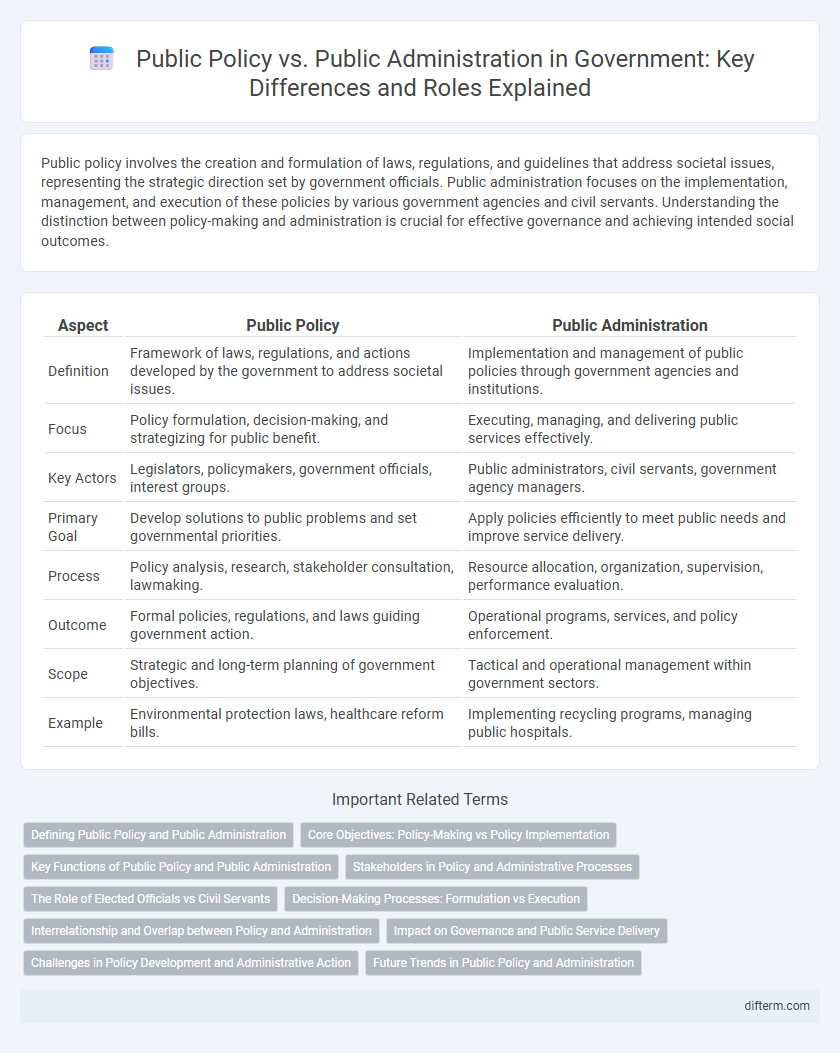Public policy involves the creation and formulation of laws, regulations, and guidelines that address societal issues, representing the strategic direction set by government officials. Public administration focuses on the implementation, management, and execution of these policies by various government agencies and civil servants. Understanding the distinction between policy-making and administration is crucial for effective governance and achieving intended social outcomes.
Table of Comparison
| Aspect | Public Policy | Public Administration |
|---|---|---|
| Definition | Framework of laws, regulations, and actions developed by the government to address societal issues. | Implementation and management of public policies through government agencies and institutions. |
| Focus | Policy formulation, decision-making, and strategizing for public benefit. | Executing, managing, and delivering public services effectively. |
| Key Actors | Legislators, policymakers, government officials, interest groups. | Public administrators, civil servants, government agency managers. |
| Primary Goal | Develop solutions to public problems and set governmental priorities. | Apply policies efficiently to meet public needs and improve service delivery. |
| Process | Policy analysis, research, stakeholder consultation, lawmaking. | Resource allocation, organization, supervision, performance evaluation. |
| Outcome | Formal policies, regulations, and laws guiding government action. | Operational programs, services, and policy enforcement. |
| Scope | Strategic and long-term planning of government objectives. | Tactical and operational management within government sectors. |
| Example | Environmental protection laws, healthcare reform bills. | Implementing recycling programs, managing public hospitals. |
Defining Public Policy and Public Administration
Public policy refers to the set of principles and actions formulated by government institutions to address societal issues and guide decision-making processes. Public administration involves the implementation and management of these policies through various governmental agencies and officials responsible for delivering public services. Understanding the distinction helps clarify the roles of policy formulation versus execution within government operations.
Core Objectives: Policy-Making vs Policy Implementation
Public policy centers on the formulation of strategic goals and regulatory frameworks designed to address societal issues, emphasizing agenda-setting, decision-making, and legislative development. Public administration focuses on executing public policies by managing resources, coordinating government agencies, and delivering services efficiently to achieve policy goals. The core divergence lies in policy-making's role in defining governmental priorities versus public administration's responsibility for operationalizing and maintaining those policies to meet public needs.
Key Functions of Public Policy and Public Administration
Public policy involves the formulation, implementation, and evaluation of laws and regulations aimed at addressing societal issues, with key functions including agenda setting, policy formulation, decision-making, implementation, and policy evaluation. Public administration is concerned with the execution and management of public programs and services, focusing on organizational structure, resource allocation, personnel management, and service delivery to ensure effective government operations. Both domains collaborate to translate governmental objectives into actionable programs that impact public welfare.
Stakeholders in Policy and Administrative Processes
Public policy involves a diverse range of stakeholders including elected officials, interest groups, and citizens who influence decision-making through advocacy and voting. Public administration engages bureaucrats, government agencies, and frontline employees responsible for implementing policies and managing public programs. Effective collaboration among these stakeholders ensures accountability, responsiveness, and the successful execution of governmental objectives.
The Role of Elected Officials vs Civil Servants
Elected officials set public policy by establishing goals, priorities, and legislation that reflect the electorate's preferences, while civil servants implement these policies through administrative procedures and day-to-day operations. The democratic accountability of elected officials contrasts with the bureaucratic expertise and continuity provided by civil servants, ensuring stability and efficiency in government functions. Clear delineation between policy-making and administration enables effective governance and responsiveness to public needs.
Decision-Making Processes: Formulation vs Execution
Public policy centers on the formulation of strategies by analyzing social needs, setting goals, and designing regulations to address public issues. Public administration involves the execution of these policies through organizing resources, managing personnel, and implementing programs to achieve governmental objectives. Effective decision-making processes require coordination between policy analysts who draft proposals and administrators who operationalize actions in compliance with legal frameworks.
Interrelationship and Overlap between Policy and Administration
Public policy establishes the framework of laws, regulations, and objectives that guide government action, while public administration executes these policies through management, implementation, and resource allocation. The interrelationship between policy and administration is critical, as effective governance depends on continuous feedback from administrators to policymakers to adjust and refine policies in response to real-world challenges. Overlap occurs when administrators participate in policy formulation and policymakers consider administrative feasibility, ensuring policies are both practical and achievable.
Impact on Governance and Public Service Delivery
Public policy establishes the strategic framework and objectives that guide government actions, shaping governance priorities and resource allocation. Public administration implements these policies through management of agencies and public services, directly influencing efficiency, transparency, and responsiveness in service delivery. Effective alignment between public policy formulation and administrative execution enhances governance outcomes by promoting accountability and meeting citizen needs.
Challenges in Policy Development and Administrative Action
Challenges in public policy development include balancing diverse stakeholder interests, addressing complex social problems, and ensuring evidence-based decision-making under political pressures. Public administration faces difficulties in effective policy implementation, resource constraints, and maintaining transparency and accountability while managing bureaucratic processes. Both areas require adaptive strategies to navigate evolving political, economic, and social environments for successful governance outcomes.
Future Trends in Public Policy and Administration
Emerging trends in public policy emphasize data-driven decision-making and the integration of artificial intelligence to enhance policy analysis and implementation. Public administration is increasingly adopting digital governance tools and fostering participatory approaches to improve transparency and citizen engagement. The convergence of these advancements is reshaping the future landscape of government operations, promoting efficiency and adaptive policy frameworks.
public policy vs public administration Infographic

 difterm.com
difterm.com